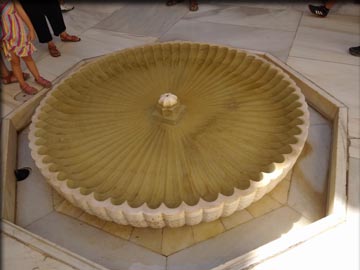pop up description layer
HOME
Cryptozoology UFO Mysteries Aviation Space & Time Dinosaurs Geology Archaeology Exploration 7 Wonders Surprising Science Troubled History Library Laboratory Attic Theater Store Index/Site Map Cyclorama
Search the Site: |
|
Tales of the Alhambra
This ancient palace perched on a hill above the old city of Granada, Spain, has been the source of myths and legends for centuries. Often they are romantic tales, but occasionally tinged with horror. The book "Tales of the Alhambra" was published in 1832. It was written by none other than Washington Irving. Yes, the same fellow we remember mainly for Halloween favorite, short story "The Legend of Sleepy Hollow" (Which was turned into a terrifying movie by Tim Burton in 1999 starring Johnny Depp.) Irving, however, did much more than write a single short story of enduring horror. In addition to being an accomplished writer he also served an historian, and diplomat. From 1842 to 1846 he even functioned as what would now be considered the ambassador to Spain. That wasn't his first trip to the country, either. In 1828 he had been in Madrid working on a biography of Christopher Columbus, when he took the time to travel to travel to the city of Granada. When he saw the town he described it as "a most picturesque and beautiful city, situated in one of the loveliest landscapes that I have ever seen."
He was particularly intrigued by the Alhambra, the remains of a fortress/palace that rose on a hill above the town. Made of a rose colored stone (in fact the name translates to "The Red One") it makes a striking image perched upon a ridge, with the mountains behind it, particularly when it is bathed in the rays of the setting sun. The Alhambra has originally been established as a military installation in 889 A.D. on top of a set of Roman era ruins. Later it was renovated by the Nasrid emir Mohammed ben Al-Ahmar of the Emirate of Granada in the mid-13th century. He turned it in to a palace. The Moors ruled from there until 1492 when the Christians managed to take control of the entire Iberian Peninsula. The palace then became the Royal Court of the Christian rulers Ferdinand and Isabella and it was in that same year that in the Alhambra's "Hall of the Ambassadors" Christopher Columbus convinced the royal couple to back his wild gambit of sailing around the world to get to the Far East. Entranced with the romance of the structure, and getting permission of the authorities, Irving moved into a room in the old palace and started researching its history with the help of Mateo Ximenes, a local guide. The book he created included myths and legends of the old palace along with the history of the buildings. The Spanish authorities were so pleased with his book and how it raised interest in the ancient structure, they named the apartment he had been staying in the "Washington Irving Room" and placed a plaque on the wall there to commemorate his work. Irving never felt he had done the palace justice, however, writing, "How unworthy is my scribbling of the place." A few Tales from Irving's Book:
The Legend of the Arabian Astrologer - In this tale Irving tells the story of a sorcerer who is employed by a Moorish, Granadian king named Aben Habuz to create a magical defense for the Alhambra. If he is successful the King promises a reward of the Astrologer's own choosing. The magician builds a tower using elements both of magic and mechanisms that when activated causes the enemy to start fighting among themselves. The device works precisely as designed and the King's enemies (who are Christian) are defeated. For his reward the sorcerer demands a beautiful Christian princess that was captured during the fighting. The King, wanting the girl for himself, reneges upon the agreement so the sorcerer seizes the princess and disappears by magic into a subterranean palace in a subterranean paradise world closing the magical gate behind him. The King wants to persuade him into the earth, but despite digging and digging he is unable to find a passage into the palace. The king, without the sorcerer to work the tower's magic, finds himself surrounded by enemies and plagued with attacks upon his kingdom. The Three Beautiful Princesses - This story tells the tale of a Granadian prince named Mohammed the Left-handed. He forces a captured Christian princess to marry and live with him at the Alhambra. The two have three beautiful daughters. After their mother dies Mohammed decides to send the girls away with the mother's maid to the Salobreņa royal castle until they are old enough to marry. When they reach this age, the maid informs the prince and the daughters are brought back to the Alhambra and locked in a tower until suitable husbands can be found for them. The girls, however, have fallen in love with three captured Spanish knights, and implore the maid to help them escape the Alhambra, along with the knights so they can flee across the moutains, cross the river and be married in the Christian town of Cordoba. The maid arranges the escape by bribing the guards and having the girls slide down a rope to get out of the tower. The youngest, Zorahayda, loses her nerve, however, and stays at the tower, eventually dying of sadness. The other princesses escape and are married to their knights, but the maid traveling with them is lost while crossing the river. Nobody knows the fate of the maid, but if she survived she was careful to stay away from the wrath of Mohammed the Left-Handed.
The Rose of the Alhambra - This tale starts during the visit of Philip V, first Bourbon ruler, to the Alhambra many years after the Moors were forced from Granada. A court page named Ruyz de Alarcon takes the queen's favorite falcon out hunting and the bird flies to the top of a seemingly abandoned tower (as it turns out it's the same one the three princesses were imprisoned in) and refuses to come down. The page knocks on the door of the tower and a beautiful young maiden of 15 peeks out the window. He implores her to let him enter the tower to retrieve the falcon, but the girl, Jacinta, tells him her spinster aunt will not let her have any contact with men. The page continues to beg her, telling her how much trouble he will get in with the queen unless he gets the falcon back, until she opens the door and allows him to climb the tower to get the bird. He does, but finds he is overcome with her beauty and pledges his love to her. She can hear her aunt returning from mass and begs him to leave giving him the rose that adorns her hair to remember her. When King Philp and his court leave the Alhambra taking the page with them, Jacinta falls into despair. It is while she is crying she sees the fountain at the base of the tower bubbling in an odd manner and from the bubbles a human form takes place. It appears to be a young girl with a lute. It is the spirit of the princess Zorahayda who still inhabits the tower. She pleads with Jacinta to preform a magical ritual to release her. Jacinta does and in gratitude the princess' spirit leaves her a magical silver lute. Jacinta, soon becomes known as the "Rose of the Alhambra" for her singing and the sound of her magical lute. Meanwhile the King has been suffering a spirit of depression which only seems to be relieved by music. The queen, hearing of Jacinta's talent, brings her, and her aunt to the court at St. Ildefonso. She comes and upon hearing the music of her magical lute, the King's spirit of depression is lifted. At the court page, Ruyz de Alarcon is reunited with Jacinta and they live happily ever after.
The Abencerrages - Perhaps the darkest tale of the Alhambra is the story of a group of people called the Aberncerrages. This group of Moors fell into the disfavor of Aben Osmyn, a cruel man who had just proclaimed himself King of Granada. Lacking support because of his cruel demeanor, Aben Osmyn soon suffered a number of defeats in his attempts to expand his dominion. He blames this on the Aberncerrages, who he felt had become disloyal to him. One by one he summoned them to the Alhambra and had them beheaded with the heads piled in the fountain in the room now know as the Hall of Abencerrages. Afterwards knowing his abilty to hold the city was slipping away, Aben Osmyn fled into the hills and became a robber chieftain. Copyright Lee Krystek 2019 All Rights Reserved. |
|
Related Links |
|
|








